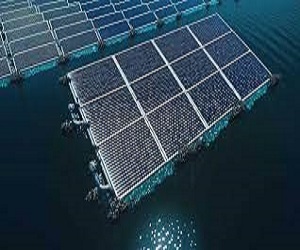Global floating photovoltaics market is projected to witness a CAGR of 11.80% during the forecast period 2024-2031, growing from USD 2.24 billion in 2023 to USD 5.46 billion in 2031. The market has experienced significant growth in recent years and is expected to maintain a strong pace of expansion in the forecast period.
There are several advantages associated with floating photovoltaic (FPV) systems, such as minimal land use, increased energy efficiency from the cooling effect of water on solar panels, and a further reduction in water evaporation of reservoirs. These benefits will drive the floating photovoltaics market growth in the coming years. Further, applications of floating photovoltaics (FPV) systems are gaining popularity in emerging countries that hold a greater number of water bodies.
Floating photovoltaic systems entail a new application of renewable energy generation, more specifically in areas with limited availability of land. The development of solar power plants on a water surface may be a valuable addition to the countries that are maximizing the use of solar energy potentials, which boosts the floating photovoltaics (FPV) market share in forecast years.
For instance, in May 2024, according to the report provided by Indo-German Technical Cooperation on Innovative Solar Organization, India will install a cumulative floating solar capacity of 30 GW from 2024 to 2040.
Utilizing Unused Water Space and Reduces Water Evaporation
Photovoltaic panels that float on the water surface offer several potential advantages over land-based solar power plants. FPV systems are the ideal solution for large water bodies that would otherwise remain idle, such as reservoirs, lakes, and dams.
FPV systems mitigate the land scarcity issue, which often limits the expansion of traditional solar farms. Floating photovoltaics (FPV) systems are an alternative solution to conventional solar panels and allow a significantly larger possible installation of panels without further competition over vital land resources, particularly in densely populated or agricultural regions, which drives the floating photovoltaics FPV market share in the forecast period.
In addition, the shed on the water surface by floating photovoltaic (FPV) systems solar panels effectively reduces the evaporation water loss, making FPV systems useful in areas that face water scarcity. Floating photovoltaics systems save water in reservoirs for drinking, irrigation, or hydropower. The conservation of water benefits local communities and supports the sustainability of agricultural and industrial operations. FPV plants are more efficient in power generation due to the water-cooling effect provided by the water bodies, which foster the floating photovoltaics market growth in the projected years.
For instance, in January 2020, SECI company requested to set up a 4-MW grid-connected floating solar PV power project at Kalpong Dam, Diglipur, and North Andaman.
In 2020, SECI company sent a proposal to the State Government of Odisha for developing a 500-MW floating photovoltaics (FPV) plant at the Hirakud reservoir.
Transition to Renewable Energy Sources to Drive Market Growth
As global energy demands rise and the push for renewable energy intensifies, floating photovoltaics portends to be the singular solution for the diversification of energy sources. The world is therefore concentrating on solar energy to transition countries into a net-zero future. The floating photovoltaics systems serve as clean and renewable energy sources that further cut down greenhouse gas emissions and other outdoor pollutants.
FPV systems may relate to the existing hydro-plant infrastructure. Furthermore, with the combination of power generation through FPV systems and hydropower, creating hybrid systems will provide a more consistent and reliable energy supply. Hybrid systems will improve grid stability and increase the viability of renewable energy as a main energy source.
The FPV systems are applicable to a wide range of environmental conditions, from an urban water body to remote locations. Additionally, floating photovoltaics (FPV) systems are scalable and flexible, enabling faster responses to growing energy demands and the urgent need for renewable energy solutions in developing countries.
For instance, in July 2022, Trina Solar reported winning a tender for a 50MWac (71MWdc) for the supply of solar modules in the floating solar photovoltaic project for the Malaysian state of Sarawak in the auction organized by Sarawak Energy Berhad. The floating photovoltaics system will be integrated with the hydroelectric plant in Batang Ai, which generates value by combining renewable energy sources and optimizing grid connectivity.
Government and Manufacture Initiatives in R&D
Government and manufacturers are taking initiatives in R&D activities on floating photovoltaics. Manufacturers are investing in developing technology, enhancing its efficiency, and facilitating the widespread adoption of the product in different geographics. Manufacturers are investing in the development of more cost-effective and adaptable floating platforms. Additional improvements aim to achieve better stability, durability, and ease of installation in any type of water body, from calm reservoirs to open seas. Furthermore, R&D is pursued in the creation of new raw materials for floating photovoltaics systems, which will open opportunities for the global floating photovoltaics market in the forecast years.
On the contrary, most governments have been compelling public research centers and private companies to cooperate. Across the world, governments are providing huge support to the research and development of floating photovoltaic technology. With the assistance of research grants, subsidies, and low-interest loans to public research center universities and firms active in developing and improving the floating photovoltaics (FPV) systems.
For instance, in 2024, the governments of Germany and India introduced a new program known as Innovative-Solar (IN-Solar). Investigating the potential of New Innovative Solar Applications (NISA) to reduce land use and encourage the focused expansion of solar PV applications in India is the aim of the I-SUN project.
Stationary Floating Solar Panels to Dominate the Global Market Share
In the forecast period, stationary floating solar panels have a high adoption rate, which leads the segment to dominate the market. Designing and installation of stationary floating solar panels is simpler and cost effective as compared to the tracking solar panels systems. The stationary floating solar panels do not involve any moving parts mechanism as tracking systems reduce the cost of panels in the market. Stationary floating solar panels offer several advantages, such as durability and cost effectiveness that foster the market’s demand.
Besides, stationary floating solar panels can be installed on different types of water bodies such as reservoirs, lakes, ponds, and coastal and offshore locations, making the system highly adaptable for different locations. The flexibility feature of stationary floating solar panels makes the system suited to several regions, including geographic locations with varied water levels or surface conditions. Several beneficial aspects of stationary floating solar panel systems sustain their dominance in the FPV market.
Asia-Pacific Leads the Floating Photovoltaics Market Share
Asia-Pacific has dominated the floating photovoltaics market share in 2023 and is expected to continue during the forecast period. Asia-Pacific comprises developing countries, and most of the countries are largely investing in renewable energy sources and reducing greenhouse gas emissions in the atmosphere. Countries such as Japan and South Korea face high population densities and limited land for large-scale solar installations. FPV systems are applied to bodies of water that are abundant in the countries to produce renewable energy. Demand for floating photovoltaics is fueled by Asia-Pacific’s large customer base countries, which include China and India. Additionally, the increasing interest in floating photovoltaics among Southeast Asian countries is expected to be a major factor in driving the market growth during the forecast period.
In January 2022, Huaneng Power International company completed the world’s largest floating PV, with a facility capacity of 320 MW in Dezhou, Shandong Province, China. The company has tied the floating array to a reservoir near Huaneng Power’s 2.65-GW Dezhou thermal power station.
Future Market Scenario (2024 – 2031F)
1. Ongoing innovations and advancement in FPV technology will improve floating platforms, buoyancy systems, and panel efficiency, which will enhance the feasibility and cost-effectiveness of these systems.
2. As environmental concerns push for more sustainable technological solutions, renewable energy sources will gain significance.
3. Solar tracking feature of hydraulic pumps will be used in the FVP systems, which is expected to boost FPV systems sales.
4. Supportive government policies and financial incentives for renewable energy projects, including FPV, in developing countries will continue to play a significant role in driving floating photovoltaics market growth.
Report Scope
“Floating Photovoltaics Market Assessment, Opportunities and Forecast, 2017-2031F”, is a comprehensive report by Markets and Data, providing in-depth analysis and qualitative and quantitative assessment of the current state of global floating photovoltaics market, industry dynamics, and challenges. The report includes market size, segmental shares, growth trends, opportunities, and forecast between 2024 and 2031. Additionally, the report profiles the leading players in the industry, mentioning their respective market share, business models, competitive intelligence, etc.
Click Here:https://www.marketsandata.com/industry-reports/floating-photovoltaics-market
About Us:
Markets and Data provides a comprehensive/ panoramic understanding of markets at global, regional, and country levels. Examine changing consumer preferences, emerging challenges, underlying trends, and growth prospects to accelerate your business strategies.
Contact
Mr. Vivek Gupta
5741 Cleveland street,
Suite 120, VA beach, VA, USA 23462
Tel: +1 (757) 343-3258
Email: [email protected]
Website: https://www.marketsandata.com




